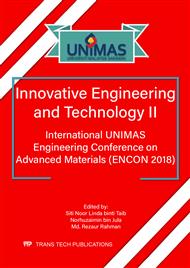[1]
M.J. Jensen, Energy processes enabled by cryogenic Carbon capture,, Brigham Young University, (2015).
Google Scholar
[2]
I. Statistics, Key world energy statistics,, Paris. International Energy Agency, (2014).
Google Scholar
[3]
M. Babar, M. A. Bustam, A. Ali, A. S. Maulud, U. Shafiq, A. M. Shariff, et al., Efficient CO2 capture using NH2− MIL− 101/CA composite cryogenic packed bed column,, Cryogenics, (2019).
DOI: 10.1016/j.cryogenics.2019.06.001
Google Scholar
[4]
U. Shafiq, A. M. Shariff, M. Babar, and A. Ali, A study on blowdown of pressurized vessel containing CO2/N2/H2S at cryogenic conditions,, in IOP Conference Series: Materials Science and Engineering, 2018, p.012077.
DOI: 10.1088/1757-899x/458/1/012077
Google Scholar
[5]
Z.Y. Yeo, T.L. Chew, P.W. Zhu, A.R. Mohamed, and S.-P. Chai, Conventional processes and membrane technology for Carbon Dioxide removal from natural gas: a review,, Journal of Natural Gas Chemistry, vol. 21, pp.282-298, (2012).
DOI: 10.1016/s1003-9953(11)60366-6
Google Scholar
[6]
M. Babar, M. Bustam, A. Ali, and A. Maulud, Identification and Quantification of CO2 Solidification in Cryogenic CO2 Capture from Natural Gas,, International Journal of Automotive and Mechanical Engineering, vol. 15, pp.5367-5367, (2018).
DOI: 10.15282/ijame.15.2.2018.16.0413
Google Scholar
[7]
S.-P. Lee, N. Mellon, A. M. Shariff, and J.-M. Leveque, High-pressure CO 2-CH 4 selective adsorption on covalent organic polymer,, Journal of Natural Gas Science and Engineering, vol. 50, pp.139-146, (2018).
DOI: 10.1016/j.jngse.2017.11.024
Google Scholar
[8]
M. Babar, M.A. Bustam, A. Ali, A.S. Maulud, U. Shafiq, A. Mukhtar, et al., Thermodynamic data for cryogenic Carbon Dioxide capture from natural gas: A review,, Cryogenics, (2019).
DOI: 10.1016/j.cryogenics.2019.07.004
Google Scholar
[9]
B. L. A. Qasim, M. Babar, A. Ali, M. A. Bustam, A. M. Shariff, Optimization in Liquid-Vapor Region for Cryogenic based Separation Simulation of Natural Gas Components,, Journal of Advanced Research in Fluid Mechanics and Thermal Sciences, vol. 55, (2018).
Google Scholar
[10]
G.-i. Kaminishi, Y. Arai, S. Saito, and S. Maeda, Vapor-liquid equilibria for binary and ternary systems containing Carbon Dioxide,, Journal of Chemical Engineering of Japan, vol. 1, pp.109-116, (1968).
DOI: 10.1252/jcej.1.109
Google Scholar
[11]
J. Davalos, W. R. Anderson, R. E. Phelps, and A. J. Kidnay, Liquid-vapor equilibria at 250.00. deg. K for systems containing Methane, Ethane, and Carbon Dioxide,, Journal of Chemical and Engineering Data, vol. 21, pp.81-84, (1976).
DOI: 10.1021/je60068a030
Google Scholar
[12]
K. Nagahama, H. Konishi, D. Hoshino, and M. Hirata, Binary vapor-liquid equilibria of Carbon Dioxide-light hydrocarbons at low temperature,, Journal of Chemical Engineering of Japan, vol. 7, pp.323-328, (1974).
DOI: 10.1252/jcej.7.323
Google Scholar
[13]
A. Ali, K. Maqsood, N. Syahera, A. Shariff, and S. Ganguly, Energy minimization in cryogenic packed beds during purification of natural gas with high CO2 content,, Chemical Engineering & Technology, vol. 37, pp.1675-1685, (2014).
DOI: 10.1002/ceat.201400215
Google Scholar
[14]
C. Song, Y. Kitamura, and S. Li, Optimization of a novel cryogenic CO2 capture process by response surface methodology (RSM),, Journal of the Taiwan Institute of Chemical Engineers, vol. 45, pp.1666-1676, (2014).
DOI: 10.1016/j.jtice.2013.12.009
Google Scholar
[15]
M. Babar, M. Bustam, A. Maulud, and A. Ali, Optimization of cryogenic Carbon Dioxide capture from natural gas,, Materialwissenschaft und Werkstofftechnik, vol. 50, pp.248-253, (2019).
DOI: 10.1002/mawe.201800202
Google Scholar
[16]
J. Davis, N. Rodewald, and F. Kurata, Solid‐liquid‐vapor phase behavior of the Methane‐Carbon Dioxide system,, AIChE Journal, vol. 8, pp.537-539, (1962).
DOI: 10.1002/aic.690080423
Google Scholar


